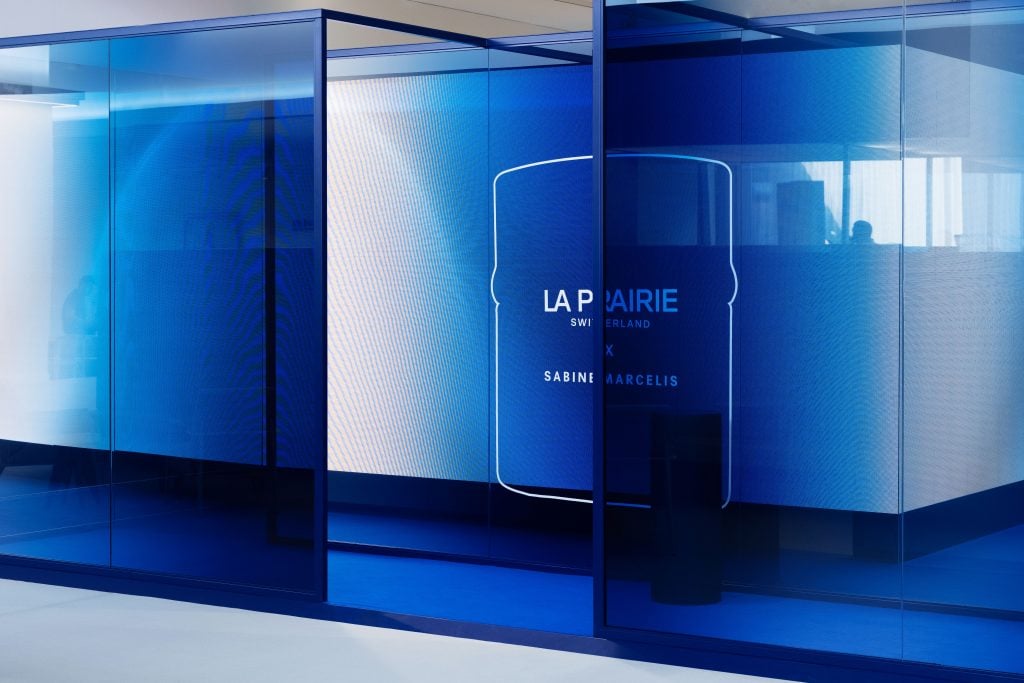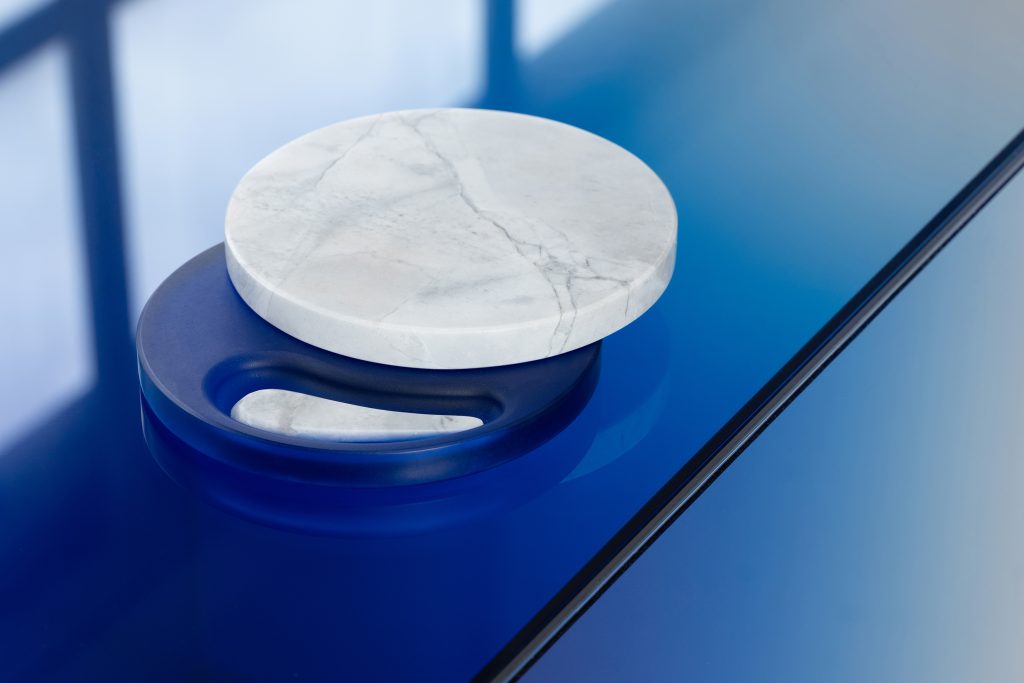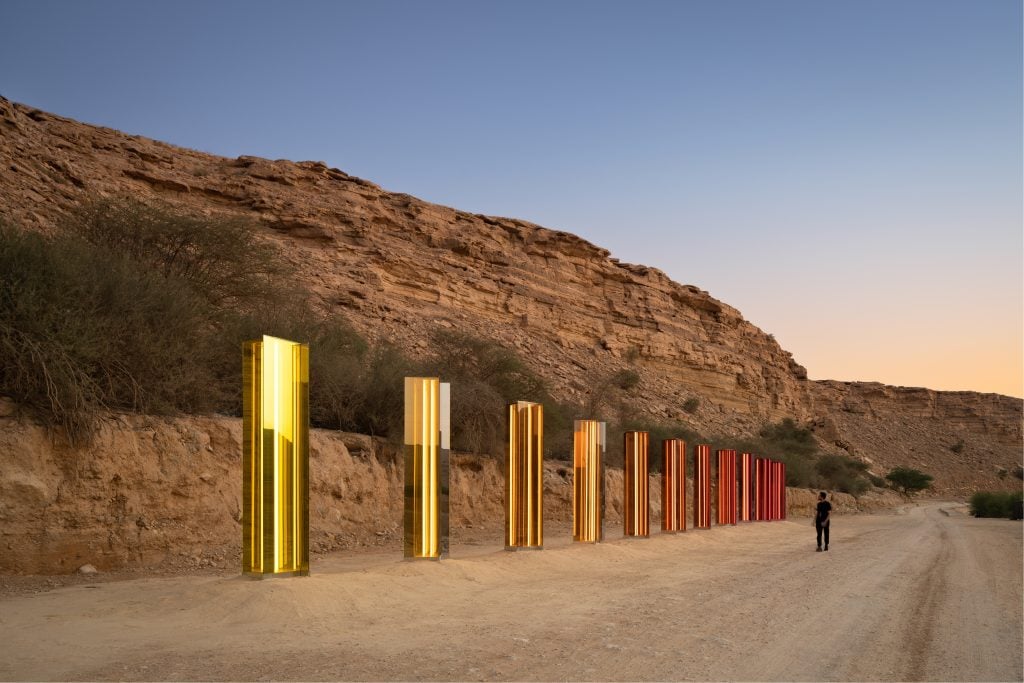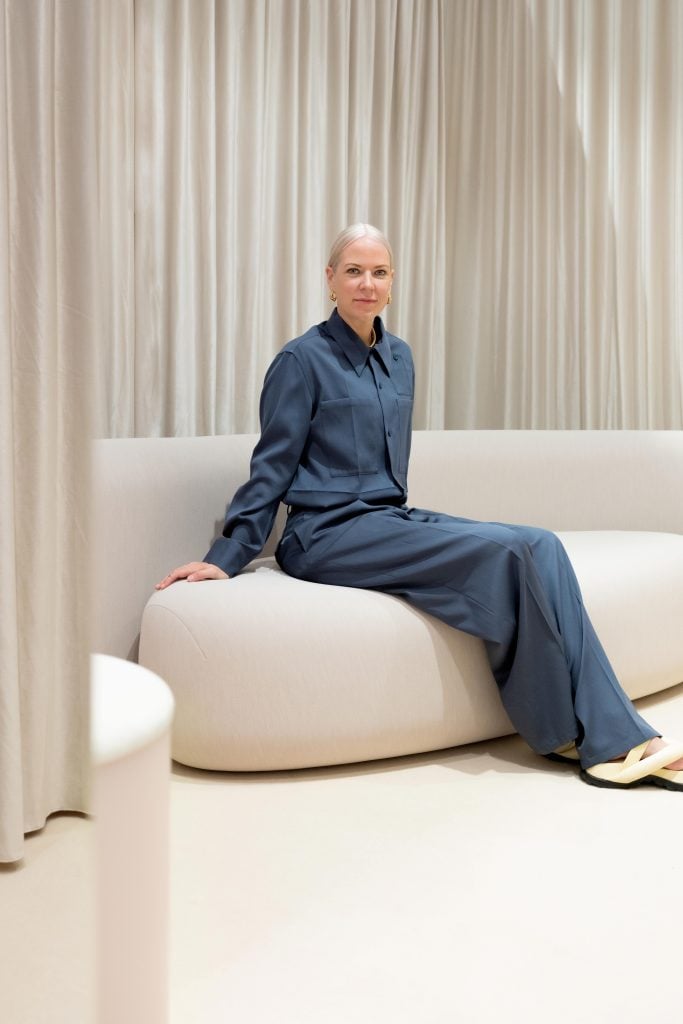In her illustrious career, the award-winning designer Sabine Marcelis has produced enchanting pastel resin dining tables; cubist armchairs in travertine and quartz; a mirrored, geometric beehive; and a monumental 11-column illuminated glass art installation in the desert outside Riyadh, Saudi Arabia. But she had yet to conquer a sofa until earlier this year.
The inspiration for her curvy, undulating couch was the zenith of haute skincare, La Prairie’s Skin Caviar Luxe Cream. “My first couch has forced me to use materials I’ve never worked with before: soft materials,” Marcelis said. “I’m always working with hard materials like glass and natural stone.” She added, “It was an intuitive process. How do you take this product out? It’s like a swoosh, you know? And how can that become a sofa but still be ergonomic and still have something to offer that other sofas don’t?” The shape mimics the freeform consistency of the substance, and the supple fabric matches the cream’s beigey, off-white hue. It was a painstaking process to color match.
“We worked with an amazing upholsterer in the Netherlands to make sure that everything had as few seams as possible,” Marcelis said. “That’s always my big thing. If you’re using organic shapes, normally there’s a lot of seams to make that happen, or puckering. But this sofa, there’s only two visible seams in the whole thing, which I’m super grateful for.”
The couch is just one component of a multitiered rollout celebrating the 25th anniversary of Skin Caviar (the product has also been reformulated for the occasion).

The Cobalt House at Art Basel. Courtesy of La Prairie.
“It was about translating a product into a spatial experience,” said Marcelis, who has collaborated with La Prairie before, including mentoring the artists in last year’s Women’s Bauhaus Collective initiative. She continued, “I approached it in quite a literal way where I looked at the jar and opened it and just wanted to think about it as, okay, what if we just literally make this product a space? And the duality, the exterior of the product is this intense blue glass. But then when you open it, it’s a very different world where the product is this very lush, rich beige cream, silky smooth.”
The project began with the Cobalt House, which debuted at Art Basel in June: an oasis from the bustling fair, its opaque walls referencing La Prairie’s packaging color which is itself originally a nod to the feminist artist Niki de Saint Phalle, one of the brand’s signatures since 1982. Guests could recline on her sofas and purchase her limited-edition La Prairie x Sabine Marcelis Skin Caviar capsule. The elegantly amorphous and swivelable tray will be treasured as an objet once the product is used. It includes another design first for Marcelis: a mini applicator spatula that doubles as a facial massage tool.

La Prairie x Sabine Marcelis Skincare Ritual. Courtesy of La Prairie.
“I’ve never worked on anything that was in such close proximity to the human body,” Marcelis observed. “OK, I create pieces that you can sit on, but that’s the extent of the interaction. This spatula is an object that touches your hand, it touches your face, it touches the product. It has to do all those things in an ergonomic, safe way, but also in an interesting and an aesthetic way. It’s a lot of things to tackle within such a small object. It brought me back to my design studies, where you really have to work with form and detail, down to which millimeter the radius is going to be, instead of these bigger gestures, which is where my studio has been moving towards in recent years.”

A view of Marcelis’s 2022 artwork Light Horizon in the Riyadh desert. Courtesy of the artist.
Marcelis hails from New Zealand but is based in Rotterdam, in the Netherlands. This year she won Designer of the Year at Elle Décor’s 2023 International Design Awards. Expectedly, her docket is exceedingly full, with a slew of projects on the horizon. In October, the OMA-designed high-rise Toranomon Hills Station Tower will debut in Tokyo Japan with Marcelis contributing the glass design on the escalators and elevators. “The building has a metro station incorporated into the lower levels,” she said. “So I approached the color scheme with an ‘above and below’ idea: Everything above has warm, earthy tints and everything below has more of a water vibe, with green and blue. Also, within the architectural design there is actual water flowing next to the blue color scheme as well.”
On October 22 Marcelis will debut a new artwork outside of the Pyramids of Giza as part of the Art D’Egypte cultural platform. She was coy about the contours, but hinted, “I’ve been working with this layered glass for many years, and recently we’ve been able to also incorporate solar cells within those layers. So we’re putting more sculptural pieces in outdoor spaces, but they’re also generating electricity by just being outside and acting as a big solar cell, which is a super exciting space to work in.”









